An Analysis of Cultural Self Awareness and Cultural Intelligence Essay
VerifiedAdded on 2021/05/31
|5
|1478
|178
Essay
AI Summary
This essay delves into the concepts of cultural self-awareness and cultural intelligence, emphasizing their importance in navigating cross-cultural interactions. It defines cultural intelligence as the ability to interact effectively with people from different cultural backgrounds, highlighting the significance of understanding one's own cultural biases and the impact of culture on behavior. The essay explores the role of cultural awareness in avoiding miscommunication and fostering cultural competence, especially in the context of a globalized workforce. It also discusses the cultural quotient and its relevance for managers and organizations dealing with diverse teams, emphasizing the need for cultural intelligence in the workplace. The essay concludes by recommending that individuals and organizations make a committed effort to be culturally aware and intelligent, offering insights into how to establish cultural competence and foster effective communication across cultures. References to relevant literature are included to support the arguments presented.
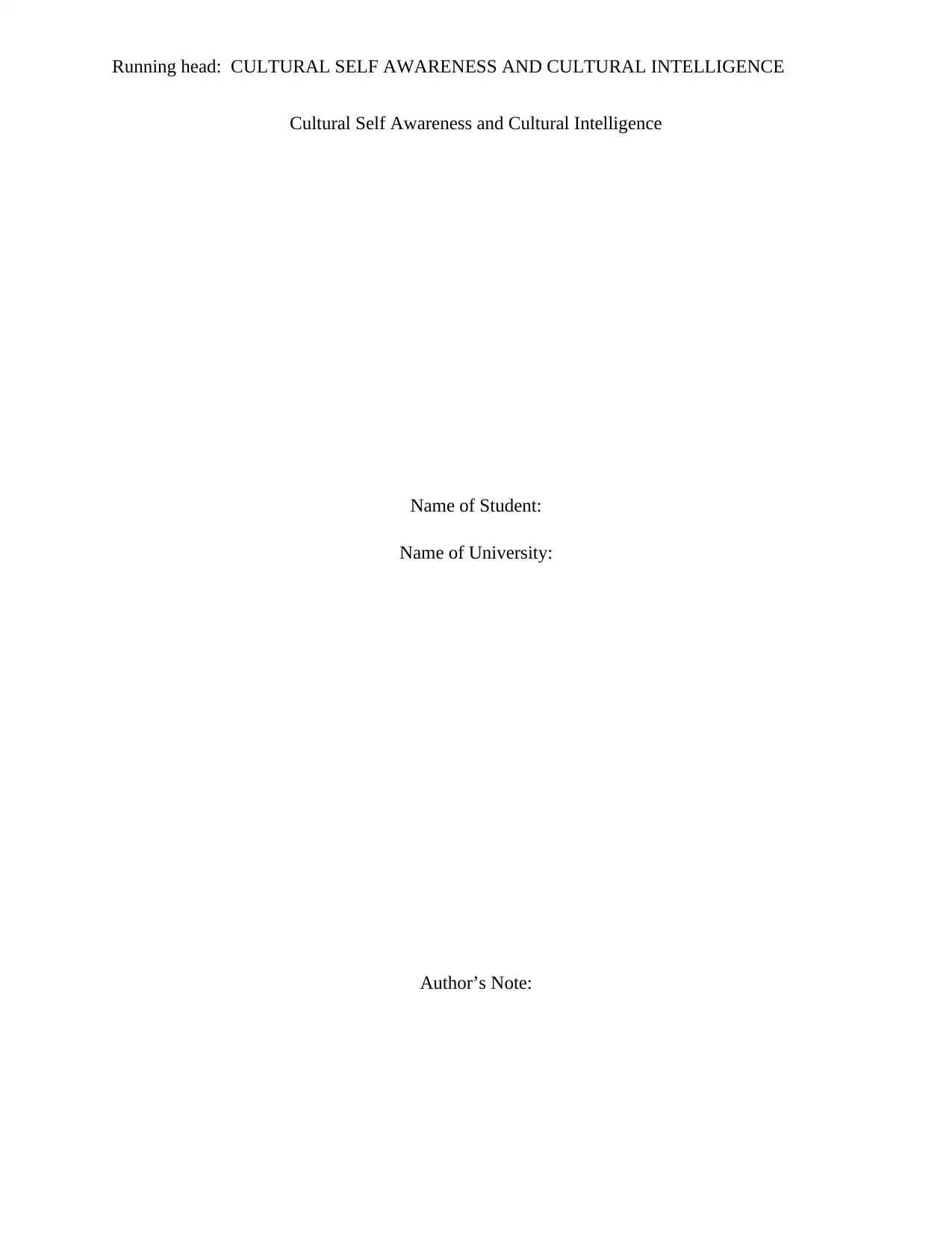
Running head: CULTURAL SELF AWARENESS AND CULTURAL INTELLIGENCE
Cultural Self Awareness and Cultural Intelligence
Name of Student:
Name of University:
Author’s Note:
Cultural Self Awareness and Cultural Intelligence
Name of Student:
Name of University:
Author’s Note:
Paraphrase This Document
Need a fresh take? Get an instant paraphrase of this document with our AI Paraphraser
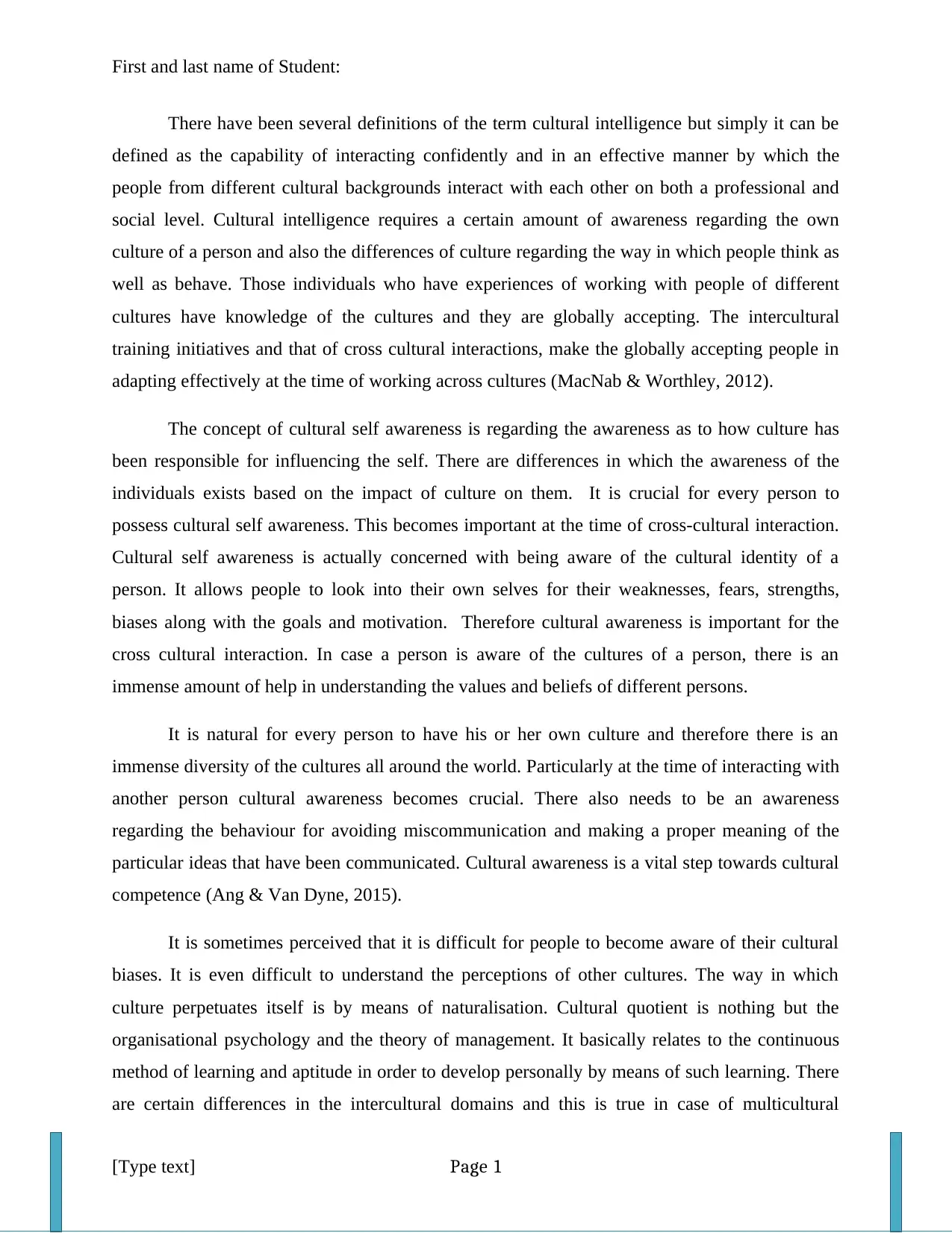
First and last name of Student:
There have been several definitions of the term cultural intelligence but simply it can be
defined as the capability of interacting confidently and in an effective manner by which the
people from different cultural backgrounds interact with each other on both a professional and
social level. Cultural intelligence requires a certain amount of awareness regarding the own
culture of a person and also the differences of culture regarding the way in which people think as
well as behave. Those individuals who have experiences of working with people of different
cultures have knowledge of the cultures and they are globally accepting. The intercultural
training initiatives and that of cross cultural interactions, make the globally accepting people in
adapting effectively at the time of working across cultures (MacNab & Worthley, 2012).
The concept of cultural self awareness is regarding the awareness as to how culture has
been responsible for influencing the self. There are differences in which the awareness of the
individuals exists based on the impact of culture on them. It is crucial for every person to
possess cultural self awareness. This becomes important at the time of cross-cultural interaction.
Cultural self awareness is actually concerned with being aware of the cultural identity of a
person. It allows people to look into their own selves for their weaknesses, fears, strengths,
biases along with the goals and motivation. Therefore cultural awareness is important for the
cross cultural interaction. In case a person is aware of the cultures of a person, there is an
immense amount of help in understanding the values and beliefs of different persons.
It is natural for every person to have his or her own culture and therefore there is an
immense diversity of the cultures all around the world. Particularly at the time of interacting with
another person cultural awareness becomes crucial. There also needs to be an awareness
regarding the behaviour for avoiding miscommunication and making a proper meaning of the
particular ideas that have been communicated. Cultural awareness is a vital step towards cultural
competence (Ang & Van Dyne, 2015).
It is sometimes perceived that it is difficult for people to become aware of their cultural
biases. It is even difficult to understand the perceptions of other cultures. The way in which
culture perpetuates itself is by means of naturalisation. Cultural quotient is nothing but the
organisational psychology and the theory of management. It basically relates to the continuous
method of learning and aptitude in order to develop personally by means of such learning. There
are certain differences in the intercultural domains and this is true in case of multicultural
[Type text] Page 1
There have been several definitions of the term cultural intelligence but simply it can be
defined as the capability of interacting confidently and in an effective manner by which the
people from different cultural backgrounds interact with each other on both a professional and
social level. Cultural intelligence requires a certain amount of awareness regarding the own
culture of a person and also the differences of culture regarding the way in which people think as
well as behave. Those individuals who have experiences of working with people of different
cultures have knowledge of the cultures and they are globally accepting. The intercultural
training initiatives and that of cross cultural interactions, make the globally accepting people in
adapting effectively at the time of working across cultures (MacNab & Worthley, 2012).
The concept of cultural self awareness is regarding the awareness as to how culture has
been responsible for influencing the self. There are differences in which the awareness of the
individuals exists based on the impact of culture on them. It is crucial for every person to
possess cultural self awareness. This becomes important at the time of cross-cultural interaction.
Cultural self awareness is actually concerned with being aware of the cultural identity of a
person. It allows people to look into their own selves for their weaknesses, fears, strengths,
biases along with the goals and motivation. Therefore cultural awareness is important for the
cross cultural interaction. In case a person is aware of the cultures of a person, there is an
immense amount of help in understanding the values and beliefs of different persons.
It is natural for every person to have his or her own culture and therefore there is an
immense diversity of the cultures all around the world. Particularly at the time of interacting with
another person cultural awareness becomes crucial. There also needs to be an awareness
regarding the behaviour for avoiding miscommunication and making a proper meaning of the
particular ideas that have been communicated. Cultural awareness is a vital step towards cultural
competence (Ang & Van Dyne, 2015).
It is sometimes perceived that it is difficult for people to become aware of their cultural
biases. It is even difficult to understand the perceptions of other cultures. The way in which
culture perpetuates itself is by means of naturalisation. Cultural quotient is nothing but the
organisational psychology and the theory of management. It basically relates to the continuous
method of learning and aptitude in order to develop personally by means of such learning. There
are certain differences in the intercultural domains and this is true in case of multicultural
[Type text] Page 1
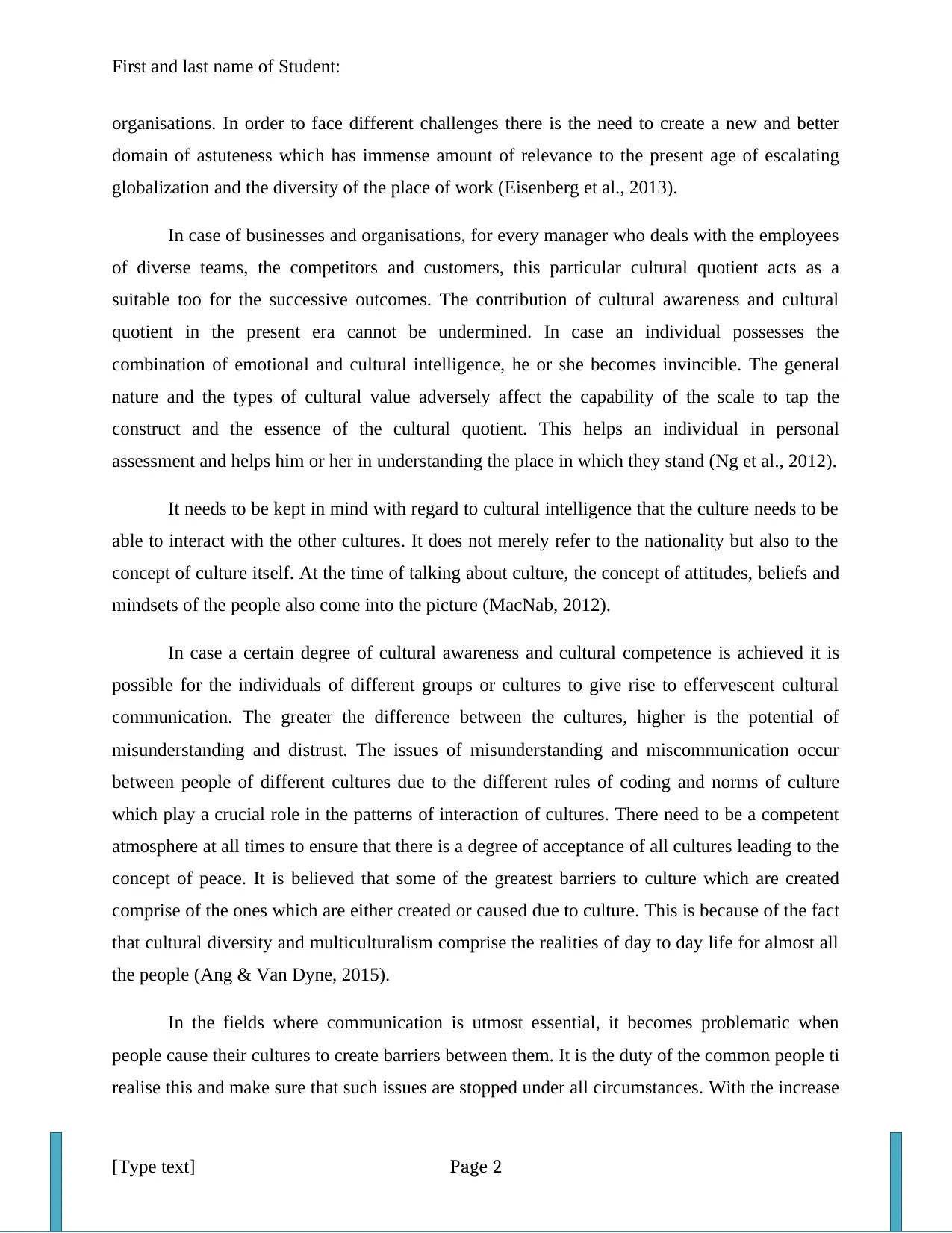
First and last name of Student:
organisations. In order to face different challenges there is the need to create a new and better
domain of astuteness which has immense amount of relevance to the present age of escalating
globalization and the diversity of the place of work (Eisenberg et al., 2013).
In case of businesses and organisations, for every manager who deals with the employees
of diverse teams, the competitors and customers, this particular cultural quotient acts as a
suitable too for the successive outcomes. The contribution of cultural awareness and cultural
quotient in the present era cannot be undermined. In case an individual possesses the
combination of emotional and cultural intelligence, he or she becomes invincible. The general
nature and the types of cultural value adversely affect the capability of the scale to tap the
construct and the essence of the cultural quotient. This helps an individual in personal
assessment and helps him or her in understanding the place in which they stand (Ng et al., 2012).
It needs to be kept in mind with regard to cultural intelligence that the culture needs to be
able to interact with the other cultures. It does not merely refer to the nationality but also to the
concept of culture itself. At the time of talking about culture, the concept of attitudes, beliefs and
mindsets of the people also come into the picture (MacNab, 2012).
In case a certain degree of cultural awareness and cultural competence is achieved it is
possible for the individuals of different groups or cultures to give rise to effervescent cultural
communication. The greater the difference between the cultures, higher is the potential of
misunderstanding and distrust. The issues of misunderstanding and miscommunication occur
between people of different cultures due to the different rules of coding and norms of culture
which play a crucial role in the patterns of interaction of cultures. There need to be a competent
atmosphere at all times to ensure that there is a degree of acceptance of all cultures leading to the
concept of peace. It is believed that some of the greatest barriers to culture which are created
comprise of the ones which are either created or caused due to culture. This is because of the fact
that cultural diversity and multiculturalism comprise the realities of day to day life for almost all
the people (Ang & Van Dyne, 2015).
In the fields where communication is utmost essential, it becomes problematic when
people cause their cultures to create barriers between them. It is the duty of the common people ti
realise this and make sure that such issues are stopped under all circumstances. With the increase
[Type text] Page 2
organisations. In order to face different challenges there is the need to create a new and better
domain of astuteness which has immense amount of relevance to the present age of escalating
globalization and the diversity of the place of work (Eisenberg et al., 2013).
In case of businesses and organisations, for every manager who deals with the employees
of diverse teams, the competitors and customers, this particular cultural quotient acts as a
suitable too for the successive outcomes. The contribution of cultural awareness and cultural
quotient in the present era cannot be undermined. In case an individual possesses the
combination of emotional and cultural intelligence, he or she becomes invincible. The general
nature and the types of cultural value adversely affect the capability of the scale to tap the
construct and the essence of the cultural quotient. This helps an individual in personal
assessment and helps him or her in understanding the place in which they stand (Ng et al., 2012).
It needs to be kept in mind with regard to cultural intelligence that the culture needs to be
able to interact with the other cultures. It does not merely refer to the nationality but also to the
concept of culture itself. At the time of talking about culture, the concept of attitudes, beliefs and
mindsets of the people also come into the picture (MacNab, 2012).
In case a certain degree of cultural awareness and cultural competence is achieved it is
possible for the individuals of different groups or cultures to give rise to effervescent cultural
communication. The greater the difference between the cultures, higher is the potential of
misunderstanding and distrust. The issues of misunderstanding and miscommunication occur
between people of different cultures due to the different rules of coding and norms of culture
which play a crucial role in the patterns of interaction of cultures. There need to be a competent
atmosphere at all times to ensure that there is a degree of acceptance of all cultures leading to the
concept of peace. It is believed that some of the greatest barriers to culture which are created
comprise of the ones which are either created or caused due to culture. This is because of the fact
that cultural diversity and multiculturalism comprise the realities of day to day life for almost all
the people (Ang & Van Dyne, 2015).
In the fields where communication is utmost essential, it becomes problematic when
people cause their cultures to create barriers between them. It is the duty of the common people ti
realise this and make sure that such issues are stopped under all circumstances. With the increase
[Type text] Page 2
⊘ This is a preview!⊘
Do you want full access?
Subscribe today to unlock all pages.

Trusted by 1+ million students worldwide
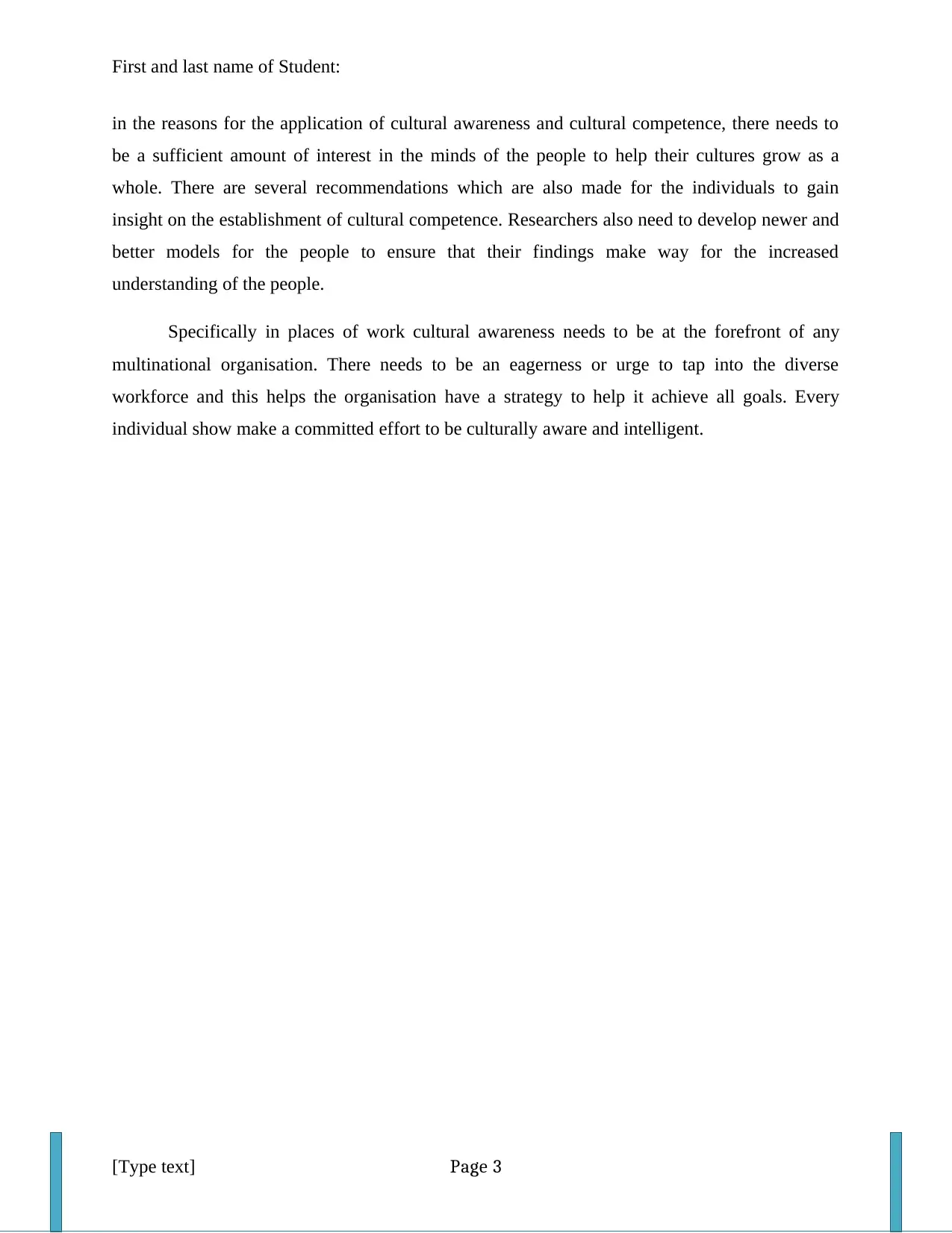
First and last name of Student:
in the reasons for the application of cultural awareness and cultural competence, there needs to
be a sufficient amount of interest in the minds of the people to help their cultures grow as a
whole. There are several recommendations which are also made for the individuals to gain
insight on the establishment of cultural competence. Researchers also need to develop newer and
better models for the people to ensure that their findings make way for the increased
understanding of the people.
Specifically in places of work cultural awareness needs to be at the forefront of any
multinational organisation. There needs to be an eagerness or urge to tap into the diverse
workforce and this helps the organisation have a strategy to help it achieve all goals. Every
individual show make a committed effort to be culturally aware and intelligent.
[Type text] Page 3
in the reasons for the application of cultural awareness and cultural competence, there needs to
be a sufficient amount of interest in the minds of the people to help their cultures grow as a
whole. There are several recommendations which are also made for the individuals to gain
insight on the establishment of cultural competence. Researchers also need to develop newer and
better models for the people to ensure that their findings make way for the increased
understanding of the people.
Specifically in places of work cultural awareness needs to be at the forefront of any
multinational organisation. There needs to be an eagerness or urge to tap into the diverse
workforce and this helps the organisation have a strategy to help it achieve all goals. Every
individual show make a committed effort to be culturally aware and intelligent.
[Type text] Page 3
Paraphrase This Document
Need a fresh take? Get an instant paraphrase of this document with our AI Paraphraser
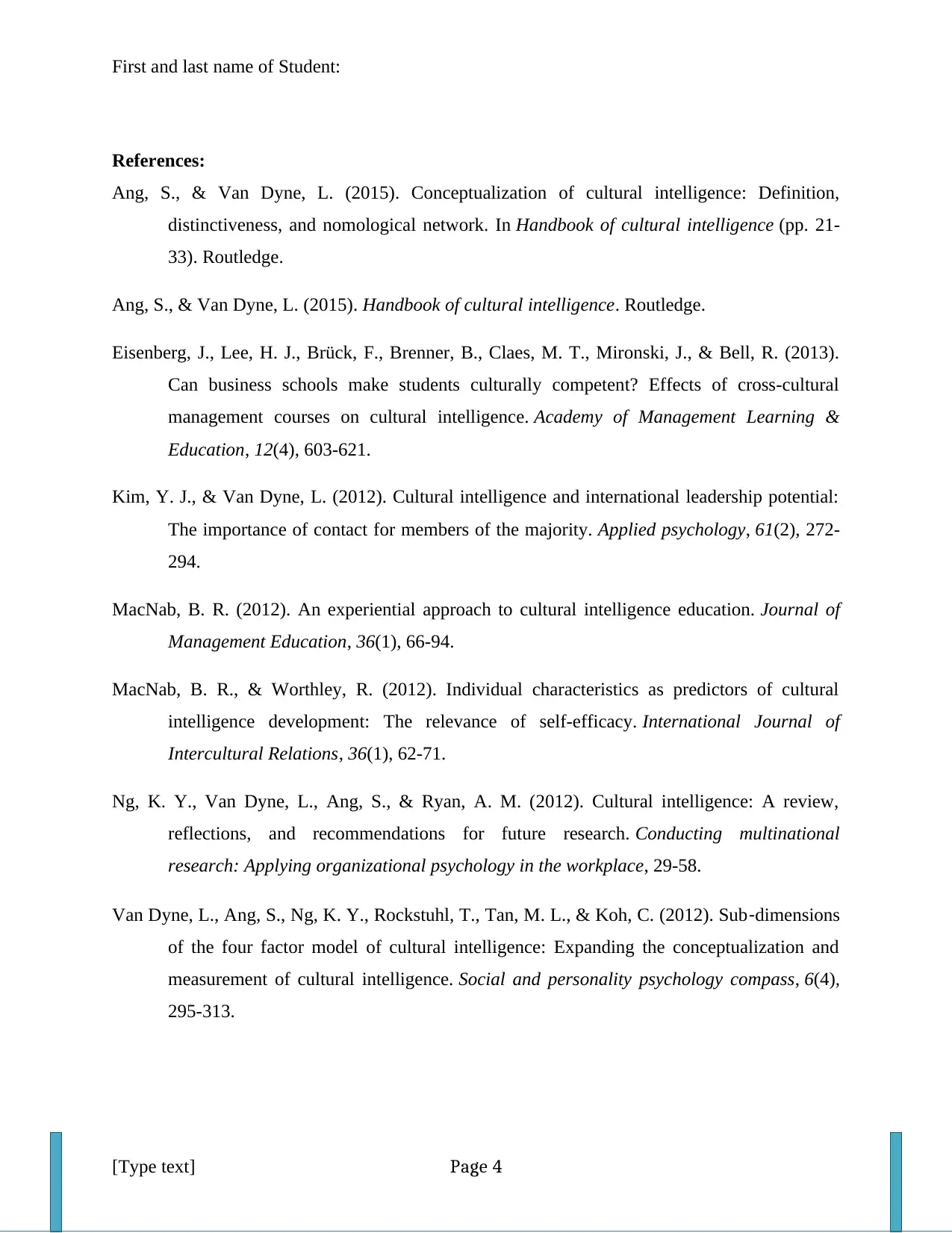
First and last name of Student:
References:
Ang, S., & Van Dyne, L. (2015). Conceptualization of cultural intelligence: Definition,
distinctiveness, and nomological network. In Handbook of cultural intelligence (pp. 21-
33). Routledge.
Ang, S., & Van Dyne, L. (2015). Handbook of cultural intelligence. Routledge.
Eisenberg, J., Lee, H. J., Brück, F., Brenner, B., Claes, M. T., Mironski, J., & Bell, R. (2013).
Can business schools make students culturally competent? Effects of cross-cultural
management courses on cultural intelligence. Academy of Management Learning &
Education, 12(4), 603-621.
Kim, Y. J., & Van Dyne, L. (2012). Cultural intelligence and international leadership potential:
The importance of contact for members of the majority. Applied psychology, 61(2), 272-
294.
MacNab, B. R. (2012). An experiential approach to cultural intelligence education. Journal of
Management Education, 36(1), 66-94.
MacNab, B. R., & Worthley, R. (2012). Individual characteristics as predictors of cultural
intelligence development: The relevance of self-efficacy. International Journal of
Intercultural Relations, 36(1), 62-71.
Ng, K. Y., Van Dyne, L., Ang, S., & Ryan, A. M. (2012). Cultural intelligence: A review,
reflections, and recommendations for future research. Conducting multinational
research: Applying organizational psychology in the workplace, 29-58.
Van Dyne, L., Ang, S., Ng, K. Y., Rockstuhl, T., Tan, M. L., & Koh, C. (2012). Sub‐dimensions
of the four factor model of cultural intelligence: Expanding the conceptualization and
measurement of cultural intelligence. Social and personality psychology compass, 6(4),
295-313.
[Type text] Page 4
References:
Ang, S., & Van Dyne, L. (2015). Conceptualization of cultural intelligence: Definition,
distinctiveness, and nomological network. In Handbook of cultural intelligence (pp. 21-
33). Routledge.
Ang, S., & Van Dyne, L. (2015). Handbook of cultural intelligence. Routledge.
Eisenberg, J., Lee, H. J., Brück, F., Brenner, B., Claes, M. T., Mironski, J., & Bell, R. (2013).
Can business schools make students culturally competent? Effects of cross-cultural
management courses on cultural intelligence. Academy of Management Learning &
Education, 12(4), 603-621.
Kim, Y. J., & Van Dyne, L. (2012). Cultural intelligence and international leadership potential:
The importance of contact for members of the majority. Applied psychology, 61(2), 272-
294.
MacNab, B. R. (2012). An experiential approach to cultural intelligence education. Journal of
Management Education, 36(1), 66-94.
MacNab, B. R., & Worthley, R. (2012). Individual characteristics as predictors of cultural
intelligence development: The relevance of self-efficacy. International Journal of
Intercultural Relations, 36(1), 62-71.
Ng, K. Y., Van Dyne, L., Ang, S., & Ryan, A. M. (2012). Cultural intelligence: A review,
reflections, and recommendations for future research. Conducting multinational
research: Applying organizational psychology in the workplace, 29-58.
Van Dyne, L., Ang, S., Ng, K. Y., Rockstuhl, T., Tan, M. L., & Koh, C. (2012). Sub‐dimensions
of the four factor model of cultural intelligence: Expanding the conceptualization and
measurement of cultural intelligence. Social and personality psychology compass, 6(4),
295-313.
[Type text] Page 4
1 out of 5
Related Documents
Your All-in-One AI-Powered Toolkit for Academic Success.
+13062052269
info@desklib.com
Available 24*7 on WhatsApp / Email
![[object Object]](/_next/static/media/star-bottom.7253800d.svg)
Unlock your academic potential
Copyright © 2020–2025 A2Z Services. All Rights Reserved. Developed and managed by ZUCOL.





